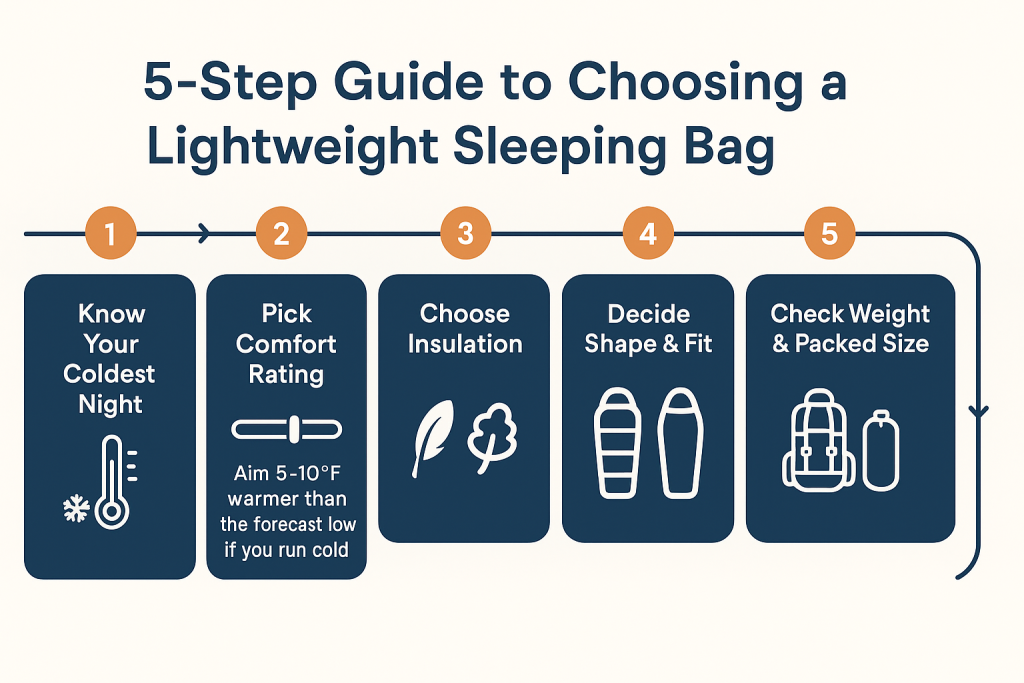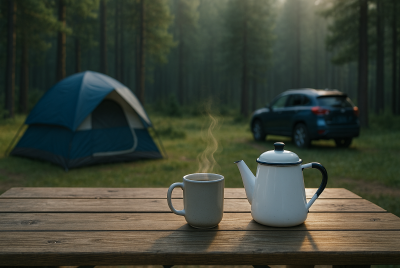Lightweight Sleeping Bags vs. Wool Throws for Autumn Trips
We may earn a commission for purchases made using our links. Please see our disclosure to learn more.
You know that moment when you’re lying in your tent at 3 a.m., staring into the dark, thinking, “Why are my feet colder than my ex’s heart?”
Most of us have done at least one autumn trip with “it’ll be fine” gear: a wool throw from the couch, an old comforter, maybe a random blanket from the trunk. And then we discover that cozy-on-the-sofa doesn’t always mean cozy-in-the-woods.
That’s where lightweight sleeping bags really shine. They’re designed to trap heat, cut drafts, and pack small enough that you don’t feel like you’re hauling a giant pillow everywhere.
Why Autumn Nights Feel Colder Than You Expect
Autumn is sneaky. The afternoon hike feels warm and golden, but once the sun drops:
- Clear skies let heat escape
- Moist air makes the chill feel sharper
- Cold ground quietly steals warmth from your body
If you’ve ever layered hoodies, socks, and a wool throw and still shivered, it’s not you. It’s just that you were fighting physics with living-room gear.
Lightweight Sleeping Bags vs. Wool Throws at a Glance
Lightweight sleeping bags are basically personal climate pods:
- Wrap around your body to block drafts
- Use insulation (down or synthetic) that traps warm air
- Add extras like hoods, draft collars, and zipper baffles
Wool throws are awesome for:
- Campfire hangs
- Cabin couches
- Mild nights
…but they’re still just flat rectangles. Air escapes from the sides, and any time you roll over, gaps open up. On chilly autumn nights, even a budget 3-season sleeping bag will almost always beat a wool throw for actual sleep.
What Counts as a “Lightweight” Sleeping Bag?
“Lightweight” depends on your trip style:
- Backpacking: Roughly 1–2.5 lb (450 g–1.1 kg)
- Car camping: Up to ~3 lb is still reasonable if it packs decently small
Key things that make a bag feel light in real life:
- Insulation type:
- Down sleeping bags give more warmth for less weight.
- Synthetic sleeping bags are slightly heavier but more forgiving when damp.
- Down sleeping bags give more warmth for less weight.
- Shape: Mummy or semi-rectangular bags use less material and insulation.
- Fabric: Thinner, durable shell fabrics reduce bulk.
You don’t need the lightest ultralight sleeping bag on the market—just something your shoulders and backpack are happy with.

Temperature Ratings You Can Actually Trust
Most modern backpacking sleeping bags now use standardized lab tests (EN or ISO standards) for temperature ratings. You’ll usually see:
- Comfort: The temp where a “cold sleeper” can stay comfortable
- Limit: The lower edge for a “warm sleeper” curled up
- Extreme: Survival only (don’t plan trips around this number)
For autumn trips, many people are happy with:
- 40°F / 4–5°C comfort in mild areas
- 20–30°F / –6 to –1°C comfort in colder forests and mountains
If you run cold, you’re tired, or your sleeping pad isn’t great, aim for a warmer rating than the forecast suggests.
Down vs. Synthetic for Misty Autumn Trips
Here’s the quick version:
Down insulation
- Excellent warmth-to-weight and very compressible
- Great for ultralight sleeping bags and long treks
- Loses performance when wet and needs more careful care
Synthetic insulation
- Keeps more warmth if damp and dries faster
- Usually cheaper
- Heavier and bulkier for the same warmth
If your autumn trips are mostly dry and you care about every ounce, a down sleeping bag is magical. If you’re dealing with coastal fog, condensation, or unpredictable weather, a synthetic 3-season sleeping bag can feel a lot less stressful.
When a Wool Throw Is Enough (and When It’s Not)
There are times when a wool throw totally works:
- Inside a van or RV as an extra layer
- On warm shoulder-season nights
- Around the campfire before bed
Where it struggles:
- Clear, frosty nights
- Windy, exposed campsites
- Backpacking, when warmth and weight really matter
Think of it this way:
- Sleeping bag = main insulation
- Wool throw = bonus layer or comfort item
Not the other way around.

Matching Your Bag to Your Style of Trip
Ask yourself: How do I usually camp?
- Backpacking & trekking
- Look for a 3-season sleeping bag with a comfort rating around 20–30°F
- Prioritize weight, pack size, and a good hood
- Look for a 3-season sleeping bag with a comfort rating around 20–30°F
- Car camping with family or friends
- You can choose a slightly roomier, softer bag
- Weight matters less, but bulk and storage still count
- You can choose a slightly roomier, softer bag
- Mixed trips (sometimes car, sometimes trail)
- A mid-weight 3-season mummy sleeping bag is a solid “one bag” solution
- Add a liner or extra blanket for colder nights
- A mid-weight 3-season mummy sleeping bag is a solid “one bag” solution
One simple question helps:
What’s the coldest realistic night I’ll face—and how far do I need to carry this bag?
Comfort Factors That Make or Break Your Sleep
Warmth is non-negotiable, but comfort is what lets you actually sleep.
Look at:
- Shape:
- Mummy = warmer and lighter, but snug
- Semi-rectangular = more room to move, slightly heavier
- Mummy = warmer and lighter, but snug
- Interior fabric:
- Softer linings feel more like a sheet than a tarp
- Softer linings feel more like a sheet than a tarp
- Details:
- Draft collar and hood
- Zipper that doesn’t snag every two seconds
- Inner pocket for phone or hand warmers
- Draft collar and hood
If you hate feeling trapped, look for “roomy mummy” or “relaxed fit” designs.
Choosing the Right Rating for Fall Conditions
Here’s a simple way to decide:
- Check the coldest overnight low for your trip.
- Add a buffer:
- Cold sleeper? Add 10–15°F (5–8°C).
- Neutral or warm sleeper? Add 5–10°F (3–5°C).
- Cold sleeper? Add 10–15°F (5–8°C).
- Base your choice on the comfort rating rather than the extreme rating.
Example:
- Forecast low: 35°F (2°C)
- You run slightly cold
- Look for a comfort rating around 25°F (-4°C)
Weight, Bulk, and Packing Strategy
For backpacking, your sleeping bag is part of the “big three” (pack, shelter, bag):
- A sub-2 lb ultralight sleeping bag can make miles feel easier.
- Pack size matters—if it compresses small, you gain space for food and layers.
For car camping, weight isn’t a dealbreaker, but bulk still affects how much other fun stuff you can bring (chairs, extra layers, even a bigger camp kitchen).
Quick Pre-Buy Checklist
When you’re scrolling product pages, ask:
- Does the comfort rating match my coldest expected night?
- Is it a down or synthetic sleeping bag, and does that fit my usual weather?
- What’s the weight and packed size?
- Does the shape (mummy vs rectangular) match how I like to sleep?
- Is there a reasonable warranty or brand reputation behind it?
If it feels right on all of these, you’re probably on the right track.
Amazon Picks: Lightweight Sleeping Bags for Autumn
Therm-a-Rest Questar 20F/-6C Lightweight Down Mummy Sleeping Bag
A premium 3-season down bag with 650-fill hydrophobic down, designed for backpackers who want warmth without much weight.
- Best for: Serious 3-season backpacking
- Why people like it: Warm, compressible, and thoughtfully designed (pad straps, cozy footbox)
- Trade-offs: Higher price and more care needed to keep down dry
Kelty Cosmic Synthetic Fill 40 Degree Backpacking Sleeping Bag
A budget-friendly synthetic sleeping bag for warmer shoulder-season trips and late-summer backpacking.
- Best for: Newer backpackers in mild autumn conditions
- Why people like it: Good value, recycled materials, forgiving in damp air
- Trade-offs: Bulkier and heavier than down alternatives; better for cool, not freezing nights
TETON Sports LEEF Mummy 30°F Sleeping Bag
A synthetic mummy bag that balances warmth, price, and a slightly roomier fit than many ultralight sleeping bags.
- Best for: Teens, scouts, and budget-conscious campers
- Why people like it: Feels cozy, reasonably warm, backed by a strong warranty
- Trade-offs: Some taller users find the regular size short; zipper can be finicky on a few units
Bessport Lightweight 3-Season Ultralight Sleeping Bag
A compact, lightweight backpacking sleeping bag that aims to give you trail-friendly weight and size at a starter-friendly price.
- Best for: Casual backpackers and weekend warriors
- Why people like it: Light enough for the trail, packs down small, affordable
- Trade-offs: Temperature rating is optimistic—best for moderate shoulder-season nights
ECOOPRO Warm Weather Portable Sleeping Bag
A simple warm weather sleeping bag, perfect as a compact option for mild nights or as a “loaner bag” for friends.
- Best for: Summer, indoor use, and mild early-autumn trips
- Why people like it: Extremely packable, lightweight, and inexpensive
- Trade-offs: Not enough insulation for truly cold autumn conditions on its own
If you’re building a full car-camping setup around one of these lightweight sleeping bags, pairing it with a smart trunk system, camp lighting, and a good pad makes a huge difference. A guide like a detailed car camping essentials checklist can help you remember the small comfort items that turn a cold, chaotic night into an actually relaxing trip.

Research-Backed Insights on Warmth and Sleep Outdoors
Let’s ground things in more than just campfire stories.
A 2025 explainer on sleeping bag warmth ratings highlights that ISO 23537-1:2022 is now the main benchmark for most reputable brands, using a heated, human-shaped mannequin in a climate-controlled room to test performance. Guides like Understanding Sleeping Bag Warmth Ratings: A Guide to ISO 23537-1:2022 explain how comfort, limit, and extreme ratings work, and why comfort is usually the best number for regular campers to focus on. You can dive deeper in resources like this ISO sleeping bag warmth guide.
On insulation, outdoor experts consistently point out that down sleeping bags offer higher warmth-to-weight and better compressibility, while synthetic insulation stays warmer when wet and costs less. REI’s expert article on down vs. synthetic insulation breaks it down clearly: down is ideal when you need high performance in mostly dry conditions, while synthetic shines in damp climates, on a budget, or when you want gear that’s easier to care for.
Put simply:
- ISO-rated bags make it easier to compare warmth between brands.
- Down vs synthetic isn’t a moral issue—it’s about matching the trade-offs to your actual trips.
FAQs About Lightweight Sleeping Bags for Autumn Trips
How cold can I comfortably go with a lightweight sleeping bag in autumn?
For most autumn trips, a comfort rating between 20–40°F (-6 to 4°C) works well, depending on where you camp and how warm you normally sleep. If your forecast low is near freezing and you know you run cold, aim for something around the mid-20s°F comfort rating, plus a warm hat and decent sleeping pad.
Can I layer a wool throw over a lightweight sleeping bag for extra warmth?
Yes—and that combo can be great. Use the sleeping bag as your primary insulation and treat the wool throw like a booster. Draping the throw over the top of the bag or around your torso and hips can add a few degrees of comfort and also make you feel cozier on really chilly nights.
Is a lightweight down sleeping bag worth the higher price?
If you backpack regularly, travel with your gear, or care a lot about pack weight and size, a good down ultralight sleeping bag is usually worth it. You get better warmth-to-weight and a much smaller packed volume. If you mostly car camp a couple of weekends a year, a synthetic 3-season sleeping bag is often enough—and much easier on your budget.
What’s the difference between a summer bag and a 3-season sleeping bag?
A summer or warm-weather bag is usually rated for around 40–60°F and focuses on low weight and ventilation. A 3-season sleeping bag has more insulation, better draft protection, and is typically rated into the 20–30°F range. For most true autumn trips, a 3-season sleeping bag gives you more margin for surprise cold snaps.
How do I know if a sleeping bag will fit my body type comfortably?
Check the length and girth measurements in the product specs. If you’re tall, look for “long” versions. If you’re broad-shouldered or move around a lot, look for descriptions like “roomy mummy” or “relaxed fit.” When in doubt, measure across your shoulders and hips at home and compare those numbers to the bag’s listed dimensions.
Final Thoughts: Choose Warmth, Not Just Aesthetic
Wool throws look great in photos. Lightweight sleeping bags… look like tubes.
But when you’re lying under a sky full of stars, listening to the wind in the trees, the gear that truly matters is whatever lets you forget about the cold and focus on the moment.
If you’ve had enough shivery nights, take that as your nudge. Pick a lightweight sleeping bag that matches your climate, your body, and your style of adventure. Your future self—the one waking up warm, rested, and watching the sunrise with a hot drink—will be so, so grateful you did.




